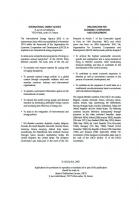New Zealand, 1769-1840: early years of western contact pk02cb01c
https://hdl.handle.net/2027/heb03868.0001.001
134 13 39MB
English Pages [238] Year 1959
Frontmatter
PART ONE: THE WHITE PENETRATION
Introduction. The First Contacts (page 3)
Chapter I. The Maori Background (page 9)
Chapter II. Traders and Whalers (page 19)
Chapter III. The Missionaries (page 38)
PART TWO: THE DEPOPULATION OF THE MAORIS
Chapter IV. Maori Health (page 57)
Chapter V. New Means of War (page 81)
PART THREE: CHANGING PATTERNS OF BEHAVIOR
Chapter VI. The European View (page 105)
Chapter VII. The Maori Domination (page 115)
Chapter VIII. The Maori Conversion (page 141)
Chapter IX. The Christian Maori (page 166)
Conclusion. New Zealand in1840, and After (page 187)
BIBLIOGRAPHICAL ESSAY (page 203)
INDEX (page 217)
Recommend Papers

- Author / Uploaded
- Harrison M Wright
File loading please wait...
Citation preview
HARVARD HISTORICAL MONOGRAPHS XLII
Published under the Direction of the Department of History from the income of The Robert Louis Stroock Fund
New Zealand, 1769-1840
Early Years of Western Contact
by
HARRISON M. WRIGHT
HARVARD UNIVERSITY PRESS Cambridge, Massachusetts 1959
© 1959 by the President and Fellows of Harvard College Distributed in Great Britain by Oxford University Press, London
Library of Congress Catalog Card Number 59~-12979
Printed in the United States of America
To my wife
PREFACE This book discusses aspects of the history of northern New Zealand before 1840 from the point of view of the interaction between the Maori and Western societies. The explorers, traders, whalers, mis-
sionaries, and other Westerners who visited New Zealand in the early years are considered primarily as the agents of change in the Maoris, and the Maoris are considered as they and their environment altered the expectations and activities of the Westerners who came to live among them. Most of the discussion revolves around the Bay of Islands, which was the area most continuously subjected to Western pressures before 1840. The South Island is rarely mentioned: while the character
of Maori-white history there was in several respects quite unlike that of the North Island, the South Island had only a very small percentage of the Maori population. The terminal date, 1840, was picked partly because the character of white immigration and Western pressures began to change shortly after that date, partly because New Zealand historians have more thoroughly examined the later years, and partly because 1840 is a convenient and well-known historical milestone. It should be pointed out that although dealing to some extent inevitably with anthropological problems the book is history and as closely as possible adheres to historical methods of presentation.
A note about the use and spelling of certain words: There is no entirely accurate and satisfactory term for the various non-Maori individuals who came to New Zealand before 1840. Except in places
where one or another is obviously necessary, I have used “white man,” “Westerner,” and “European” more or less interchangeably. Although the Maori language is fairly well stabilized, the spelling
Vill Preface of proper names (particularly of early people and places) often varies, and I have used wherever possible that adopted by J. R. Elder for his index to The Letters and Journals of Samuel Marsden, Dunedin, 1932. Quoted passages are copied as exactly as possible, however, and consequently have a variety of spelling inconsistencies.
I am indebted to many people for assistance in the writing of this book. A number of them have read all or part of the text and have given me the benefit of their special knowledge, although they are not responsible for the use to which I have put it. Among them are Professor R. G. Albion of Harvard University, Professor F. M.
Keesing of Stanford University, Mr. A. Osborn of Harvard University, and Professor H. D. Skinner of the University of Otago in Dunedin, New Zealand. I am particularly obligated to Professor David Owen of Harvard University, who was the director of the thesis which resulted in this book, and to the Department of History at Harvard, which made its publication possible. Thanks are also due the Faculty Research Committee of Swarthmore College for its aid. Members of many library staffs, particularly Mrs. Linda Rodda,
of the Hocken Library in Dunedin, have been most helpful. I am happy to acknowledge my indebtedness to the United States Educational Foundation in New Zealand for a Fulbright Scholarship. Above all, I am thankful for the opportunity to have worked under Dr. Angus Ross, Senior Lecturer in History at the University of Otago, when I was in New Zealand. Dr. Ross not only directed my first enthusiasm for the topic, but has read the manuscript at every possible stage since it was begun. His generous aid has been indispensable.
Harrison M. Wright Swarthmore, Pennsylvania February 1, 1959
NOTE Certain official publications and periodicals used frequently in the notes have been abbreviated as follows:
CMP Church Missionary Proceedings CMR Church Missionary Record HRNZ Historical Records of New Zealand, ed. by R. McNab, 2 vols., Wellington, 1908-14
[PS Journal of the Polynesian Society
MR Missionary Register
PP, 1836, VII Parliamentary Papers, 1836 (538), VII. Report From the Select Committee on Aborigines. PP, 1837-38, XXI Parliamentary Papers, 1837-38 (680), XXI. Report from the Select Committee of the House of Lords,
Appointed to Inquire into the Present State of
New Zealand...
PP, 1844, XIII Parliamentary Papers, 1844 (556), XIII. Report from the Select Committee on New Zealand ... PP, 1846, XXX Parliamentary Papers, 1846 (337), XXX. Papers Relative to New Zealand.
TPNZI The Transactions and Proceedings of the New Zealand Institute
No reference has been made in the notes to the particular station at which a missionary letter from the Bay of Islands was written, unless it differed from that missionary’s accustomed station. Following is a list of the stations of the missionaries whose letters from the Bay of Islands before 1840 are most frequently cited:
Butler, John: Kerikeri, 1819-23 Clarke, George: Kerikeri, 1824-1831; Waimate, 1831 —— Davis, Richard: Paihia, 1824-31; Waimate, 1831——
Hall, William: Rangihoua, 1814-1825 Kemp, James: Kerikeri, 1819-——
X Note
Kendall, Thomas: Rangihoua, 1815-1823
King, John: Rangihoua, 1814-32; Tepuna, 1832—— Wiliams, Henry: Paihia, 1823—— Since most of the letters referred to were addressed to one of the secretaries of the Church Missionary Society in London (usually Josiah Pratt before 1824, and Dandeson Coates after), no reference has been made in the notes to the recipient of a letter, unless it was other than a Church Missionary Society secretary. All manuscript letters are located in the Hocken Library, Dunedin, New Zealand, unless otherwise mentioned. Many of the sources for quotations can be found in several places: manuscripts, missionary periodicals, and other published works. The references in the footnotes generally rely on manuscripts and missionary publications, except for the well-edited collections of the letters and journals of John Butler and Samuel Marsden.
Contents Part ONE: THE Wuirt PENETRATION
Introduction. The First Contacts 3 Chapter I. The Maori Background 9 Chapter II. Traders and Whalers 19
Chapter III. The Missionaries 38 Part Two: THE DEPoPULATION OF THE Maonris
Chapter IV. Maori Health 57 Chapter V. New Means of War 81 Part THREE: CHANGING Patrerns oF BEHAVIOR
Chapter VI. The European View 105 Chapter VII. The Maori Domination 115 Chapter VIII. The Maori Conversion 141
Chapter IX. The Christian Maori 166 Conclusion. New Zealand in 1840, and After 187
INDEX 217
BIBLIOGRAPHICAL ESSAY 203
«
PART ONE The White Penetration
a & So Whangaron, Hasbor
eg Sah Po ee, , lle SEE — le, : iS Yo Keri, {Pung "AO: ceoF aeeeaeS There. aac if S32 ES x ec Totarig Kerikeriay $ ovaeae 0 2a.ee ae Ng es aR 4a o Martand” Bas ORS Srarekaw | opie>Whangare ye. ..SIRE OSES on ine ‘ : . . Rte: Cabed os ee. OU
SS od ES fr PEE to. Pomares REA PACS . mir AA stl Yele w2 a Bas
oo tE f thy, gkow’ OASEEA . x Kaikohe NORTH ISLAND DETAIL AREA
\ ed ‘ h
3 aPak oy » NEW ZEALAND NRIs, North [sland
Ss "@“¥ ii. A Y ° ¢ pA Hokiahgt ah Missionary Stations about 184.0
a ‘ 4 r ~* e
Rivet wbrgakahiase pane Hlead of Hoki® ae Vek. £%Great Barrier ve yan. 6 AL Island
me 4, tHaurakie
' ara _ BD By - ¢ ey ‘*Rotaruaphinemuto. ee Bay?
= coe
Harbor 30 LO TUHOES fi.
=Ie at






![Politics in the Playground: The World of Early Childhood in New Zealand [Revised, Updated]
1877372684, 9781877372681](https://ebin.pub/img/200x200/politics-in-the-playground-the-world-of-early-childhood-in-new-zealand-revised-updated-1877372684-9781877372681.jpg)


